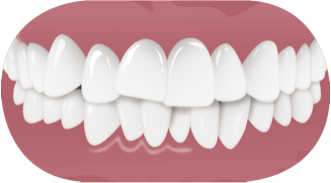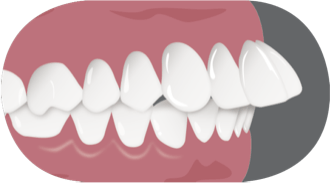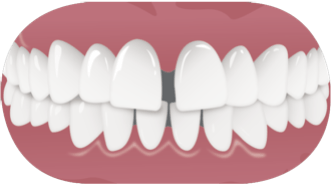
Teeth misalignment comes in many different forms and affects as much as 75% of the world’s population. And while problems like crooked teeth and overbite can cause people to feel insecure about their looks, they also pose many health concerns.
In this article, we’ll explore the most common types of teeth misalignment, the dangers associated with them, and the range of treatment options available.

Teeth misalignment – or malocclusion of the teeth – refers to any case where a person’s teeth aren’t aligned, or don’t fit inside the mouth correctly. You may have a dental malocclusion if your teeth are crowded, too spaced out, or severely rotated.
Malocclusion can also refer to the position of the jaw, which will affect the overall alignment of the teeth. Your upper teeth should overlap your lower teeth slightly, so that both sets of teeth fit naturally into each other’s grooves.
Proper alignment of the teeth helps prevent a person’s cheeks, lips and tongue from being bitten. It also allows them to brush and floss more effectively, helping to prevent build-ups of plaque and bacteria which can lead to serious health issues.
Most malocclusions are the result of a person’s genes, and dental issues are often passed from generation to generation. However, there are a number of health problems and habits that may also influence the structure of the teeth and jaw, including:
Teeth misalignment can come in many different forms. Here are some of the most common kinds of malocclusion:

Dental crowding – sometimes called crowded or crooked teeth – happens when there is not enough room in the mouth for teeth to align smoothly. The teeth compete with each other for space, ending up in crooked, unnatural positions, sometimes tilting or twisting.

Overbite refers to when the upper front teeth extend too far beyond the bottom front teeth. There are two kinds of overbites:
Most people have a normal overbite, where the upper teeth cover ½ to ⅓ of the lower teeth when biting down (usually between 2-4mm overlap). On the other hand, ‘deep’ and ‘severe’ overbites refer to overlaps of 4-8mm and 9+mm, and these forms require orthodontic attention.
Overjet – sometimes called ‘buck teeth’ – refers to the horizontal distance between the upper and lower teeth when the jaw is closed (whereas overbite refers to the vertical overlap). When the horizontal space between the upper and lower teeth exceeds 3mm, this is considered an overjet.
Overjets are usually skeletal, originating in the jaw and dental roots. They are also generally genetic – when a person has a family history of overjet, they are also likely to have one.

Underbite occurs when the lower teeth extend rather than the upper teeth. The problem usually stems from a misalignment of the jaw and can affect a person’s ability to speak properly. Underbite is also referred to as a Class III malocclusion, or prognathism.
Crossbite is similar to an underbite, where some of the upper teeth sit behind the lower teeth. However, crossbite only impacts a group of teeth, whereas an underbite affects the whole set.
There are two types of crossbite:

Open bite occurs when the front upper and lower teeth tilt outward so that they don’t touch when the jaw is resting. Open bite can be caused by skeletal problems, as well as habitual factors such as thumb sucking and tongue thrusting.

Teeth spacing – or diastema – refers to gaps between the teeth. There are a number of factors that can cause the issue, such as genetics, overgrowth of tissue in the gum line, and thumb sucking.
For many people, the superficial concerns of not having straight teeth are enough of an incentive to get orthodontic treatment. But malocclusions that are left untreated can cause all kinds of health and social problems.
Here are some of the most common dangers of misaligned teeth.
The temporomandibular joint connects your jaw to your skull. It can be subjected to stress and strain when a person’s teeth are misaligned and the upper and lower set do not fit together. This can result in TMJ disorder, causing severe headaches, jaw pain and jaw clicking.
Some kinds of malocclusion may prevent a person from chewing properly and cleanly biting off pieces of food. In such cases, a person may rely on their back teeth more than their front, causing them to wear down faster over time.
It is impossible to reach the surface of every tooth when they are overlapped, crowded and crooked. In such cases, food and bacteria can get trapped between the extremely tight spaces between them, leading to plaque and bacteria build-up. Over time, this leads to discolouration of the teeth, tooth decay, gingivitis (gum inflammation) and cavities.

Periodontal disease – or gum disease – is an infection of the soft tissues that keep your teeth in place. It is normally a result of poor oral hygiene, such as when someone can not brush or floss their teeth properly due to a malocclusion. When left untreated, gum disease can lead to sore bleeding gums, painful chewing, and tooth loss.
What’s more, intense gum disease also affects the bloodstream, and it is believed to slowly damage the blood vessels within the heart and brain. This can put a person at higher risk of stroke and heart disease.
People with severe malocclusions may have trouble forming sounds that rely on the connection of the front teeth, such as ‘C’, ‘S’ and ‘T’. This can cause many psychosocial problems in both their social and professional lives, and may lead to low self-esteem and anxiety.
When a person’s malocclusion stems in the jaw, it may restrict their ability to breath properly through the nose. This can lead to sleep apnea – a condition that causes a person to stop breathing momentarily at different points in the night. It causes fatigue and can severely impact cognitive function throughout the day.
The good news is that most common forms of malocclusion can be easily treated. Rapid technological advances in orthodontic treatment mean that most kinds of braces can generally treat misaligned teeth.
In some severe cases, one type of brace alone may not be enough to fix the issue, or surgery and facemask therapy may be required to restructure the jaw. The only way to know how to fix your misaligned teeth is by speaking to a dentist or orthodontist.
The dangers of leaving a malocclusion untreated are very serious. So if you suspect that your teeth aren’t properly aligned it’s important to get checked out by an expert.
Why not book an appointment with one of our registered experts? They will be able to advise you on the best orthodontic solution and let you know your funding options.